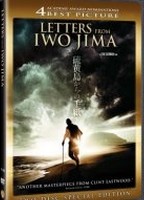 BUY IT AT AMAZON: CLICK HERE!
BUY IT AT AMAZON: CLICK HERE!
STUDIO: Warner Home Video
MSRP: $34.99
RATED: R
RUNNING TIME: 140 Minutes
SPECIAL FEATURES:
• "Red Sun, Black Sand: The Making of Letters from Iwo Jima"
• "The Faces of War: The Cast of Letters From Iwo Jima"
• "Images from the Frontlines: The Photography of Letters from Iwo Jima"
• World Premiere at Budokan in Tokyo
• Press Conference at Grand Hyatt Tokyo
The Pitch
The flipside of Flags of our Fathers – the bloody battle of Iwo Jima through the eyes of the island’s Japanese defenders.
The Humans
Ken Watanabe (The Last Samurai), Kazunari Ninomiya (Japanese pop group Arashi), Tsuyoshi Ihara (Gamera: Guardian of the Universe), Ryo Kase (Nobody Knows), Shidou Nakamura (Fearless)
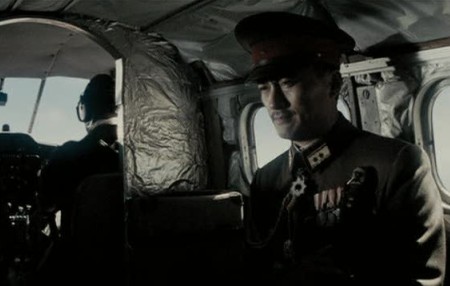
"Of all the flights, on all the airlines, I had to pick the one showing Beau Geste."
The Nutshell
In mid-1944 talented Japanese Army General Tadamichi Kuribayashi (Watanabe) arrives on Iwo Jima to take command of its defenses, finding the tiny island woefully unprepared and unsupported. There’s nothing but bad news from the front, and as a massive American invasion fleet approaches the troops become resigned to a bleak fate. There will be no surrender, or escape.
The Lowdown
To be honest it would be almost impossible for me to dislike this project. I’m a huge WWII history buff, and have long been waiting for someone to do a proper modern take on the Pacific campaign. The Thin Red Line, Flags of Our Fathers, and yes even Pearl Harbor have their moments, but to my disappointment all treat their respective battles more as sideshows than main events. As far as I’m concerned there can be no greater drama than what actually happened on the battlefield, and Letters wisely never strays far from it, though the participants desperately yearn to.
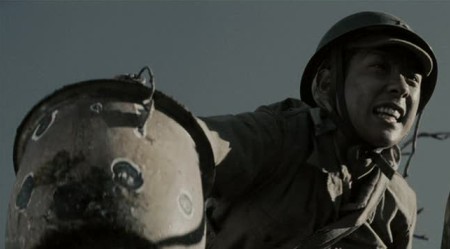
Saigo had mixed feelings about his stunning victory in Kick the Shitcan.
My hat’s off to Clint for taking on a project with such meager commercial prospects. I can’t imagine many investors clamoring to get in on a grim foreign language period piece about a hated enemy. Certainly American audiences mostly succeeded in ignoring it at the box office.
However it was a hot ticket in Japan, where it joined what seems to be a new surge of downbeat WWII films. 2005 brought the superbly Bruckheimer-iffic Otokotachi no Yamato (also featuring Nakamura), about the final voyage of the world’s largest battleship, and this month the kamikaze squadron flick Ore wa, Kimi no Tame ni Koso Shini ni Iku (For Those We Love) opened in Japan. Might be time to start keeping a watchful eye on those Honolulu skies, especially since Ore wa was written and produced by Tokyo’s ultra-nationalist governor. Then again, the Japanese public still gets nervous if their troops are dispatched to hand out lollipops less than 3 times zones from a combat area.

"Hello, 911? Yeah, you better send the police, fire department and EMS."
Certainly things were much different in 1945. As Clint remarks, Flags‘ American combatants were sent to war "hoping they were going to come back, knowing it was going to be tough," whereas their Japanese opponents in Letters "were told they weren’t coming back." Completely cut off from the Japanese mainland with no air or naval support and limited supplies, they faced an invasion force that overwhelmingly outnumbered and outgunned them in every respect. Yet under Kuribayashi’s skilled leadership they fought on in 100+ degree underground tunnels with precious little food or water, stretching a campaign expected to last 5 days to 5 weeks. In the end nearly 30,000 men died on the 8 square mile volcanic rock pile, including a staggering 95% of the 22,000 odd Japanese troops.
The film’s a compelling condemnation of the tragic futility of war, and at the same time full of admiration for those that sacrificed so much for what they believed in. It’s easy to label the staunch resistance of Iwo’s defenders as fanaticism, but at the time they saw themselves as the last line of defense separating the Americans from the Japanese mainland. There was great concern that Iwo’s airfield would be used to launch air strikes at Tokyo, just over a two-hour flight to the north.
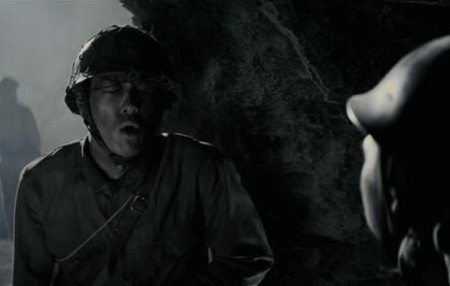
"Yes, well, your technique is impressive, but I’d like to take this opportunity to talk to about boundaries."
Like Black Hawk Down, Letters isn’t about the rights and wrongs of the big picture, but rather the courage of men under extreme duress. All politics go out the window in a scene in which a wounded American soldier is captured in the hope that he might possess valuable information. He soon dies, leaving only a letter from his mother speaking of life back home and wishing for his safe, speedy return. As an officer translates aloud, the assembled troops fall into a stunned silence, recognizing these very same sentiments from their own mothers’ correspondence.
It’s one of several emotional body blows in this very powerful film. Primarily we view them through the eyes of Saigo (Ninomiya), a humble yet cynical grunt recently conscripted. He’s bitter about having to leave his wife and newborn behind, but never wavers in his duty despite his relative indifference to Iwo’s significance. We follow him around the island on a grueling and highly perilous odyssey from digging trenches to running ammunition to braving no man’s land to preparing for the final stand. His face grows steadily longer as he witnesses all kinds of suffering and savagery, his friends dropping like flies around him. I’m no fan of his group’s tepid pop ditties, but Ninomiya anchors the film convincingly, though his wide-eyed looks of disbelief and despair may owe something to Elijah Wood’s Frodo.
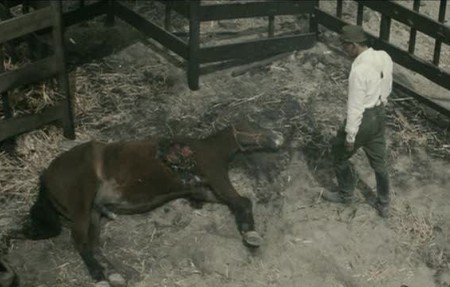
"All Seabiscuit needs is a third chance. And a necromancer."
The rest of the story focuses on Kuribayashi, giving us a top down view of the strategic situation. He keeps up a consistently brave front, only rarely addled by the increasingly gloomy intelligence reports. Like Saigo he often pauses to write his thoughts to his family back home, making up innocuous anecdotes for the kids while destruction rains around him. Having traveled abroad, he is much more worldly and open-minded than the other senior officers, largely dour conservatives who resent his unconventional ideas.
Watanabe gives a commanding performance that is alternately playful and intense. Still, despite two very moving William Wallace-esque addresses to the troops, it’s not surprising he was passed over for Best Actor, since in addition to the language and political handicaps he disappears for long stretches while the action focuses on Saigo.
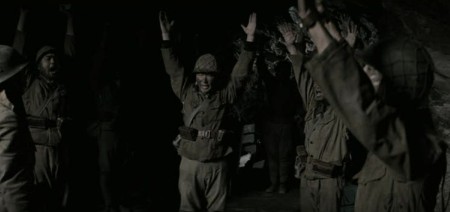
"Confidence! Confidence! Dry and secure! Raise your hands…"
As for the supporting cast, Kase provides a nice contrast to Saigo as his strait-laced comrade Shimizu, a slightly nerdy apple polisher type who slowly begins to wonder whether his unquestioning obedience to his superiors is being adequately repaid. Ihara adds a touch of glamour as the debonair playboy Baron Nishi, a former Olympic equestrian champion and friend to Hollywood stars who shares Kuribayashi’s common touch with the men. Nakamura’s Lieutenant Ito is his polar opposite, a gruff uber-macho type obsessed with going out in a blaze of glory. A tense standoff between the two develops when Ito insists on taking his men on a suicide charge.
The specter of suicide hangs heavy over the film. In the most distressing scene, a colonel who has failed to halt the American advance apologetically radios Kuribayashi to inform him over loud protests that he and his men will commit suicide to atone. As foreign as this action may seem to western viewers, it simply illustrates the backbreaking weight of duty and honor in Japanese culture at the time. It didn’t help that capture was considered more shameful still, and that they had been taught to expect little mercy from the Americans.
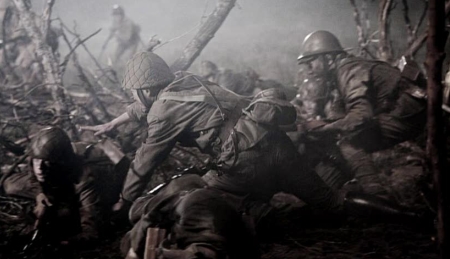
Great moments in Japanese history: November 11, 2006 – The PS3 launch
Letters shares Flags‘ elegantly desaturated, nearly monochrome look, which strikes me as a little odd. It’s one thing if you’re trying to recreate the look of an old movie, as The Good German did, but simply removing color to denote the time period is a little patronizing.
The lovely, plaintive score is also reminiscent of Flags, and effectively underscores the tragic proceedings. I haven’t thought about Kyle Eastwood since seeing Honkytonk Man eons ago, but with any luck his father will give him more composing work.
If Letters has a weak spot, it is the limited scale imposed by its modest budget. Never does the film look anything less than top notch, with California ably standing in for the much less accessible Iwo in most shots. However, the action scenes are primarily small and brief. Perhaps Eastwood felt he covered combat well enough in Flags, and it’s appropriate that we don’t see too much of outside developments since the Japanese were largely confined to tunnels.
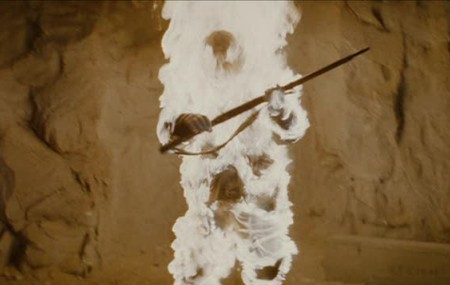
"Zoinks! Like, I think that guy’s got the hots for us Scoob!"
Nevertheless, the final battle surely deserves a more elaborate, refined presentation. It’s so rushed and randomly shot that it’s hard to tell who’s killing whom, even though the outcome is inevitable. Studying the last 10 minutes of Glory would have been helpful.
The Package
Like Flags, Letters‘ attractive but subdued cover takes the unusual route of not displaying its stars. It’s perplexing then that Eastwood, the main selling point, is credited only in tiny print.
Several of the extras are taken from the film’s Tokyo launch. "Images from the Frontlines: The Photography of Letters from Iwo Jima" is disappointingly just a brief collection of publicity stills used in the campaign. At the world premiere at the famous Budokan hall (Have you heard "I Want You to Want Me"? Yeah? Well they heard it here first.) Clint and the cast say a few words about their impressions of the film and the tragic nature of war. Somewhat more interesting is the press conference, at which Clint speaks about the challenge of directing actors in a foreign language.

"Helmet on! Apply it directly to the helmet! Helmet on! Apply it dire-KABLAM!!"
"The Faces of Combat: The Cast of Letters from Iwo Jima" offers a brief discussion of the casting process and helpful introductions to the main cast members. I expected the usual Hollywood trick of passing off Asians of various backgrounds for the required nationality (see Memoirs of a Geisha), but in this case all the principal actors are Japanese. Sorry to doubt you Clint.
"Red Sun, Black Sand: The Making of Letters From Iwo Jima" is the best of the lot, giving a solid though not too detailed overview of all aspects of production. Ironically the film’s Japanese American scribe Iris Yamashita doesn’t speak the language, so the script had to be translated into Japanese.
The lack of a commentary, even just from a historian, is rather disappointing. Apparently 30 minutes was cut from the film, so it wouldn’t be a total shock for an extended version to show up later with commentary and the soundtrack, similar to the 3-disc treatment given Mystic River and Million Dollar Baby.
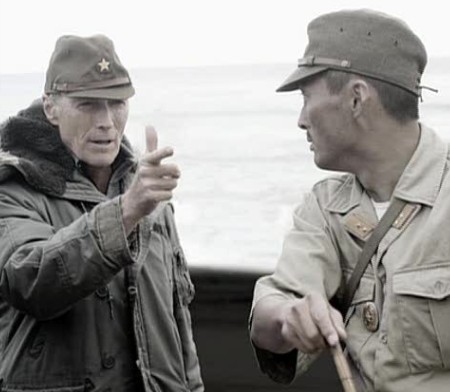
"I’m wise to you Watanabe. Don’t think I didn’t notice your copy of Honolulu’s Best Eats."
Letters from Iwo Jima joins Sam Peckinpah’s Cross of Iron as one of the very few war films to offer a fascinating look into the mind of the enemy*. It’s a must for war film fans, and a valuable reminder for today that the basic hopes and aspirations of men vary little by uniform color. For all we know the people of Tehran also dream of tossing Paris Hilton into a wood chipper. I have faith.
*Assuming you’re not reading this in the land of spontaneously combusting toilets.